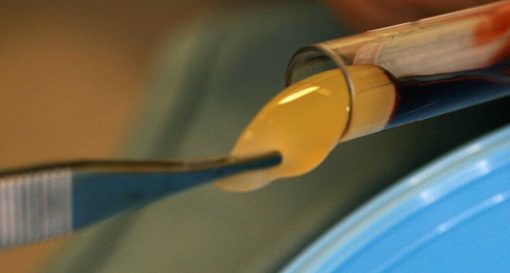What is PRF growth factor?
Platelet-rich fibrin (PRF) also called as Choukroun’s platelet-rich fibrin, a growth factor named after its inventor. Whenever there a loss of support around the affected teeth, the periodontal ligament fibres and the bone around it also affected. Regenerative procedures need carried out in this region. Regeneration of tissues and fibre expedites the healing outcome after dentistry procedure following periodontal therapy.
However, this depends on two crucial events: availability of cell types needed and presence or absence of signals necessary to recruit and stimulate the cells. The cascade of healing of any wound initiated by clot formation, followed by proliferative and maturative stage. Growth factors favor wound healing by promoting proliferation of cells (mitogenesis), migration of cells (chemotaxis), and stimulation of new blood vessel formation (angiogenesis).

Platelet-rich fibrin!
Platelets enucleated hematologic component derived from bone marrow precursor cells megakaryocytes. Platelets help in expulsion of growth factors like PDGF, TGF-β, IGF-I upon their activation. TGF-β has chemotactic effect on osteoblastic cells and endothelial cells, inhibitory effects on osteoclasts, and initiates woven bone formation. IGF-1 stimulates proliferation of osteoblasts and increases expression of osteocalcin for matrix synthesis. Hence, a combination of IGF-1 and PDGF checks the rate and quality of wound healing.
How is PRF growth factor made?
For preparation of PRF, only centrifuged blood without any addition of anticoagulant and bovine thrombin required. Blood sample taken without anticoagulant in 10-mL tubes in a glass or glass-coated plastic tube and immediately centrifuged at 3000 rpm for 10 minutes. In addition, the resultant product consists of the following three layers. Above all, top-most layer consisting of an acellular plasma, PRF clot in the middle, and a red corpuscle base at the bottom. Therefore, compression between two sterile gauzes or in a specific PRF tool, enables the clot to be transformed into a membrane.
What are the uses of PRF in dentistry?
Platelet-rich plasma (PRP) is a new approach to tissue regeneration and promotes healing in many dental and oral surgery procedures, especially in ageing patients. It used for prp tooth extraction, prp dental implants, prp bone grafts and more. Patients’ plasma contains growth factors that influence wound healing, thereby playing an important role in tissue repair. Similarly, PRF used in cases of periodontal regeneration, sinus lift, gingival recession, perio-endo lesions.
Platelet-rich fibrin (PRF) derived from the concentration of the patient’s blood platelets. A simplified chairside procedure results in the production of a fibrin membrane that can stimulate the release of many important growth factors involved during wound healing processes that take place after surgery. PRF is useful in post extraction sockets and can be used in Sinus Lifts. On the other hand PRP can be used in facial rejuvenation and also be used in case of Implantology.
Royal Dentistry | PRP PRF Oral Surgery
Advantages of using PRF in dentistry:
- Firstly, there is a simplified preparation and efficient technique just before any dental treatment
- Secondly, it accelerates the healing rate of the grafted bone
- Thirdly, it is available through autologous blood sample which can be done at clinic itself
- Minimal blood manipulation required
- The natural fibrin framework that stimulates tissue regeneration effectively
- Above all, when used along with bone grafts, it is a quick as well as an economical alternative when compared with recombinant growth factors.
Follow Us For More Updates” We then concentrate the white blood cells or fibrin obtained from the blood plasma. These components help your tissues quickly regenerate.
We apply the PRP or PRF on the affected area (where you had a dental procedure done). Your stem cells strengthen and develop new tissue for speedy healing.”
Dr. Chirag Chamria







PRF also called as Choukroun’s platelet-rich fibrin, a growth factor named after its inventor. Regeneration of tissues and fiber expedites the healing outcome after dentistry procedure following periodontal therapy.